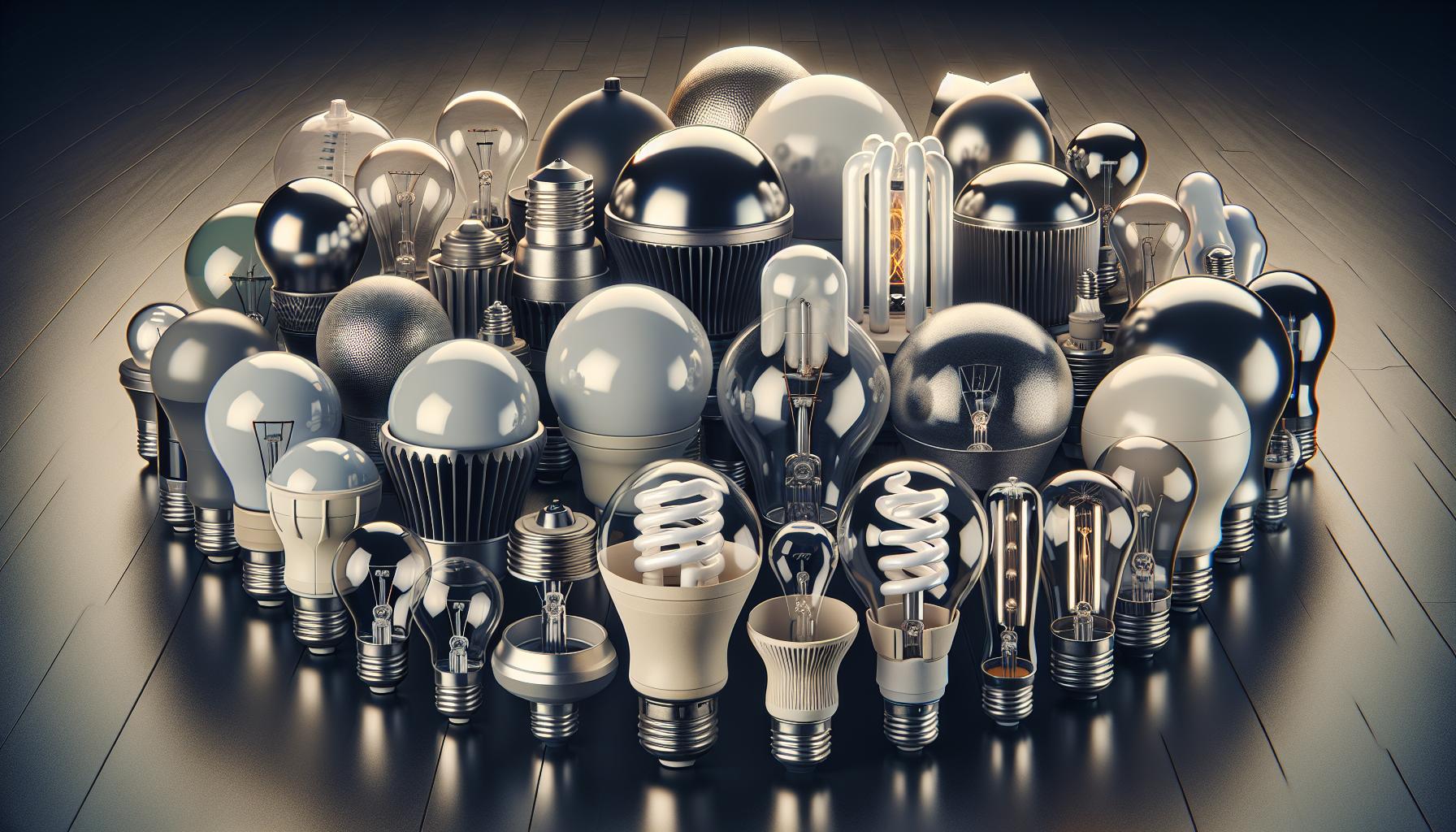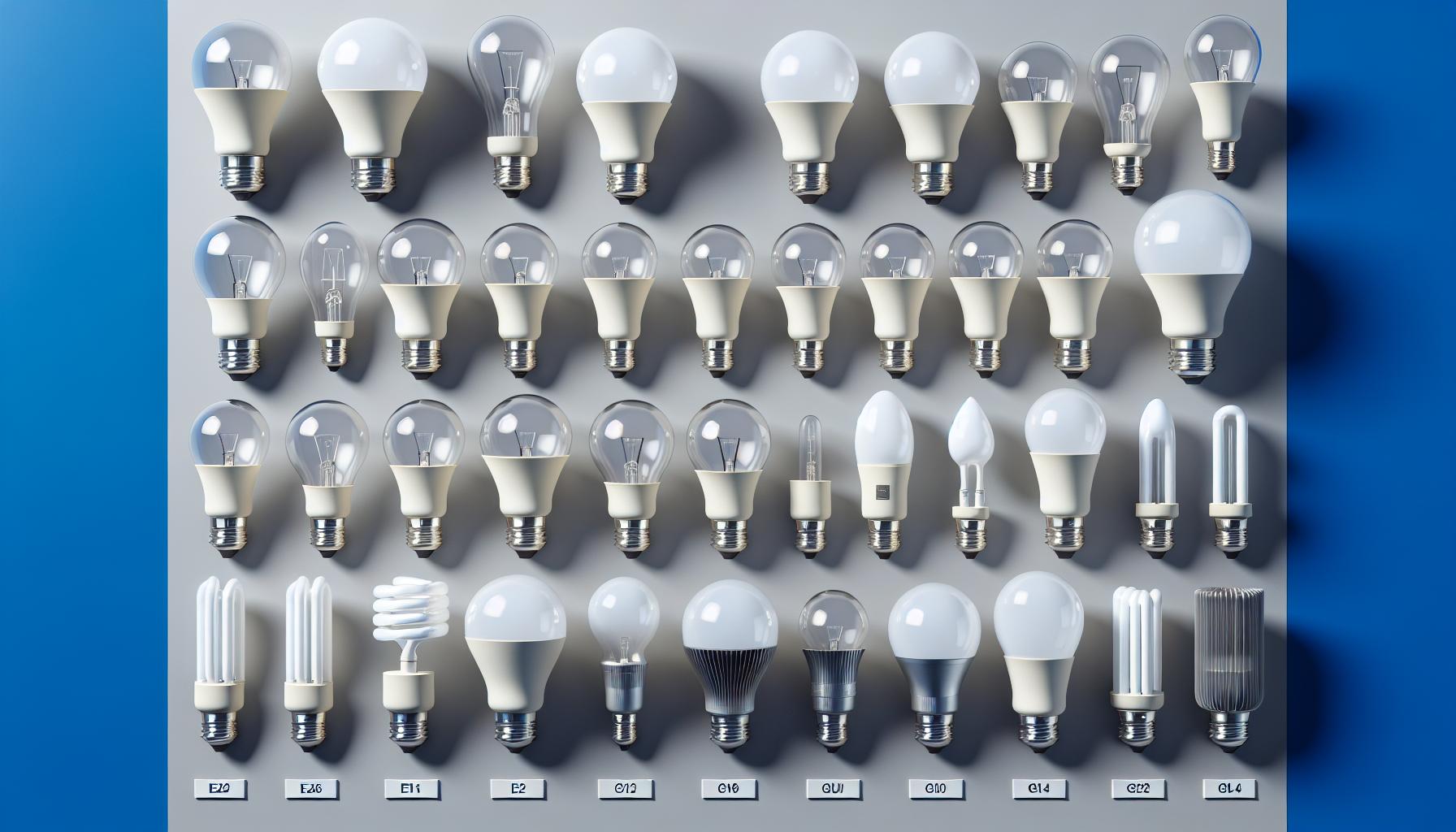Ever found yourself squinting at the lighting aisle, wondering which bulb will fit your fixture at home? You’re not alone. Picking the right light bulb size is crucial, but it’s often overlooked until you’re standing under the harsh store lights, decision time ticking away.
Why light bulb size matters
When you’re knee-deep in home DIY projects, it’s clear that details make all the difference. In the realm of lighting, choosing the right light bulb size is as crucial as selecting the perfect shade of paint for your walls. Light bulb size affects not only the aesthetics of your fixtures but also how they illuminate your space.
Incorrect bulb sizing can lead to a few problems:
- Aesthetic imbalance: Bulbs too large might protrude from the lampshade or fixture, while those too small could get lost visually, altering the intended design.
- Functional issues: Oversized bulbs could heat up and damage fixtures, whereas undersized ones may create ineffective lighting.
- Safety hazards: Bulbs that don’t fit properly can overheat or even shatter, posing significant safety risks.
In the journey to light perfection, you’ll encounter a plethora of bulb sizes, each designed for specific functions and fixtures. For instance, a standard A19 bulb, which measures 19 eighths of an inch in diameter, may be the right fit for your table lamp, but not for your recessed ceiling lights, which may require something more streamlined like an MR16 or GU10 bulb.
Bulb Sizes and Their Corresponding Fixtures
Table Lamps and Floor Lamps:
- A19 bulbs
- A21 for larger lamps
Recessed Lighting:
- MR16
- GU10
- PAR variations for wider beams
Chandeliers and Decorative Fixtures:
- B10 candelabra bulbs
- CA10 for a more flame-like shape
Outdoor and Security Lights:
- PAR38 for flood lighting
- BR40 for wide, diffused lighting
Having a grasp on the correlation between bulb sizes and their best-suited fixtures will elevate your DIY lighting projects from amateur hour to professional elegance. Remember, your lights aren’t just about seeing your surroundings; they’re about creating an experience, a mood, and complementing the design of your home. So before you make that trip to the store, arm yourself with knowledge about which bulb size befits your specific lighting vision. Armed with that knowledge, you’ll find yourself breezing through aisles with confidence, ready to bring a well-lit harmony to your home.
Understanding light bulb sizing
Navigating through the world of light fixtures can sometimes feel like you’re learning a new language. But don’t worry, you’ll soon master the vocabulary. Understanding light bulb size is crucial for both the look and function of your lighting. You’ll encounter a range of bulb sizes, each designed for specific fixtures and purposes. It’s about pairing the perfect bulb with the appropriate fixture, much like matching the right shoes to an outfit.
Bulb shapes and sizes are often indicated by a letter or series of letters followed by a number. The letter typically represents the shape or type of the bulb, while the number refers to the bulb’s diameter at its widest point, measured in eighths of an inch. For example, an A19 bulb is an “A” shape bulb that is 19 eighths of an inch (or 2 and 3/8 inches) in diameter.
When you’re ready to check your light bulb size, turn off the lamp or fixture first. Once it’s safe, unscrew the bulb and take a look at its base. There, you should find an imprint or a sticker displaying the bulb size and type. Armed with this information, you’re well on your way to choosing the appropriate bulb for your fixture. If the marking has faded, or you’re just inclined to measure, roll out your ruler or a measuring tape. Measure the diameter of the bulb at its widest point to determine the size.
Consider these bulb types and their usual applications:
- A19: The classic shape for table and floor lamps
- MR16: A compact size great for directed lighting, such as track or landscape fixtures
- GU10: Often used in recessed or directional fixtures
- B10: The elegant choice for chandeliers and sconces
« Is a Light Bulb a Good or Service? The Surprising Dual Role Unveiled
How Does a Light Bulb Security Camera Work? Unveiling Secret Tips for Your Safety »
Remember, a bulb that’s too large might not fit your fixture or could overpower the space, while one that’s too small may diminish the light’s effectiveness or throw off the symmetry of the design. Just like the little details in a DIY project can have a big impact, so too can the size of your light bulbs. Keep this guide handy, and you’ll illuminate your space with confidence and style.
Tips for checking light bulb size in your fixture
You’ve probably been in a situation where your light burnt out, and you’re left fumbling for a new bulb without a clue about the right size. No worries! With these simple steps, replacing a bulb is as effortless as flipping a switch.
First things first, power off the fixture. Safety’s not just a suggestion; it’s a must. Once that’s done, remove the bulb by unscrewing it from the socket. Now, look for the code printed on the bulb’s base. This alphanumeric code, like an A19 or a PAR30, is your bulb’s ID badge, telling you the shape and size at a glance.
If the code’s rubbed off or missing, grab a ruler or a measuring tape. Measure the bulb’s diameter at its widest part. Remember to measure in eighths of an inch, since that’s the standard sizing for light bulbs in the US. Now, convert those eighths of an inch to a whole number, and you’ve got the size part of your bulb’s code.
Got a smartphone? Use it to your advantage. Snap a pic of the bulb while it’s still in your hand. This can help when you’re at the store comparing options or if you need a second opinion. Plus, a picture’s worth a thousand words when you’re seeking help online from fellow DIYers or lighting experts.
While you’re at it, check the fixture too. Some fixtures have maximum wattage restrictions. Stick to these limits to prevent overheating, which can be dangerous and reduce the lifespan of your bulb.
Lastly, consider upgrading to LED bulbs if you’re still using incandescents. They’re more energy-efficient, last longer, and come in various shapes and sizes that fit almost any fixture. Plus, you won’t be doing this as often.
Using a ruler or measuring tape for accurate measurements
When the alphanumeric code on your bulb’s base is elusive or worn away, where do you turn? Trusty manual measuring, of course! You might be a DIY enthusiast or a lighting aficionado, but precise measurements are crucial when it comes to light bulbs. It’s essential to ensure you’re buying the right size for your fixture.
Grab your ruler or measuring tape, and let’s get technical. The diameter of a light bulb is measured in eighths of an inch. Take your ruler and measure straight across the bulb’s widest point. Remember, you’re aiming to count the eighths. So, if your bulb’s diameter measures 2 inches across, you’ll convert that to 16 eighths (since there are 8 eighths in an inch).
When the numbers start fusing into one big blur, here’s a simple breakdown to keep it all straight:
| Inches | Eighths of an Inch |
|---|---|
| 2″ | 16/8 |
| 2.5″ | 20/8 |
| 3″ | 24/8 |
| 3.5″ | 28/8 |
Be precise when lining up your ruler or tape measure; even a small misstep can lead to an incorrect size. This becomes especially critical with globe and decorative shaped bulbs, where precision can impact both aesthetics and fit.
What about bulbs that are tucked into awkward places? Sometimes fixtures don’t make it easy. You might need to carefully unscrew the bulb first. For recessed lighting, or when fixtures are high up, a stepladder and a spotter can come in handy to ensure safety. Once you have access, measure as described.
Having a reference photo while you measure can help you keep track of details. Details such as the exact position on the bulb where you took the reading and the orientation. All this forethought eliminates guesswork and ensures that when the time comes to replace or upgrade, you’re armed with knowledge.
With your measurements in hand, replacing old bulbs is a breeze. Whether it’s your favorite reading lamp or an elegant chandelier, the right fit will have your space glowing in no time. Remember, good lighting isn’t just about brightness; it’s the perfect harmony between function and design.
Common light bulb sizes and fittings
When you’re scratching your head looking at light bulb options, knowing the most common sizes and fittings can be a real lifesaver. Let’s dive right into the world of light bulb dimensions and how they fit into your daily life.
Discover Your Bulb Base
First up, the part of the bulb that screws or snaps into the fixture is the base. They come in several types, but here are the ones you’ll bump into frequently:
- E26: This is the standard medium base in the US and it’s likely what’s in your table lamp or ceiling fixture.
- E12: Known as the candelabra base, this smaller thread is typical for decorative lamps and chandeliers.
- GU10: This base has a twist-and-lock mechanism, often seen in track lighting or recessed downlights.
- G4: It’s a bi-pin base you’d find in smaller, often halogen, fixtures like under-cabinet lights.
For each, just think of the letter as the type and the number as the millimeter width across the base.
Bulb Shapes and Terms
Now let’s talk bulb body. The shape is coded by letters and numbers, like A19 or G25, hinting at the form and diameter.
Here are some shapes you should familiarize yourself with:
- A19: Your standard bulb shape used in most general lighting.
- BR30: This bulb is a bit wider and often used in recessed can lights.
- G25: Globe-shaped, these bulbs look fantastic in bathroom vanities or pendant lights.
Each shape serves its unique purpose, offering different diffusion of light and aesthetic appeal to match your space.
| Shape | Common Use |
|---|---|
| A19 | General lighting |
| BR30 | Recessed lighting |
| G25 | Vanities and pendants |
Knowing these details can sharpen your DIY projects, ensuring your spaces shine both functionally and beautifully. Don’t forget to keep your reference photo handy and use these tips to match the perfect bulb to its place in your home.
Conclusion
Armed with the know-how to measure and identify your light bulb size, you’re now ready to make informed choices for your space. Remember, getting the right fit isn’t just about function—it’s about creating the perfect ambiance for your home or office. So go ahead, measure up, and light up your world with confidence!
Frequently Asked Questions
What is the first step in checking the size of a light bulb in a fixture?
To correctly check the size of a light bulb in a fixture, first, ensure the power is off, then carefully unscrew the bulb from the fixture.
How can I identify the shape and size of a light bulb?
Look for an alphanumeric code on the base of the light bulb. This code indicates both the shape and size of the bulb.
What should I do if the light bulb lacks an alphanumeric code?
If the code is missing, use a ruler or measuring tape to measure the diameter of the bulb’s widest part in eighths of an inch.
Is taking a photo of the light bulb helpful for future reference?
Yes, taking a picture of the light bulb can be very helpful when you need to shop for a replacement or seek assistance online.
Why should I check the fixture for maximum wattage restrictions?
It’s important to check for wattage restrictions to prevent overheating, which can lead to fixture damage or be a fire hazard.
What are the benefits of upgrading to LED bulbs?
Upgrading to LED bulbs is recommended for increased energy efficiency and a longer lifespan compared to traditional bulbs.
Why is it important to know the common sizes and fittings of light bulbs?
Understanding common bulb sizes and fittings ensures that you purchase the right fit for your fixture, maintaining both functional lighting and design aesthetics.





